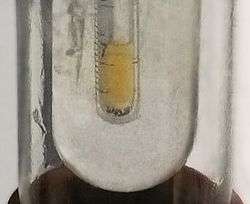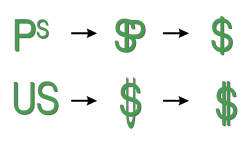Definify.com
Definition 2026
弗
弗
Translingual
Han character
弗 (radical 57 弓+2, 5 strokes, cangjie input 中中弓 (LLN), four-corner 55027, composition ⿻⿰丿丨弓)
Derived characters
References
- KangXi: page 356, character 16
- Dai Kanwa Jiten: character 9708
- Dae Jaweon: page 673, character 1
- Hanyu Da Zidian: volume 2, page 990, character 9
- Unihan data for U+5F17
Chinese
|
simp. and trad. |
弗 | |
|---|---|---|
Glyph origin
Pictogram (象形) – two arrows, tied together to be straightened.
Later borrowed phonetically to mean “no”. The derivative 拂 stands for the original word in Modern Chinese.
Etymology
See etymology of 不.
Pronunciation
- Mandarin
- (Standard Chinese, Beijing)+
- Pinyin:
- Zhuyin: ㄈㄨˊ
- Wade-Giles: fu2
- Gwoyeu Romatzyh: fwu
- IPA (key): /fu³⁵/
- (Standard Chinese, Beijing)+
- Cantonese
- (Standard Cantonese, Guangzhou)+
- Jyutping: fat1
- Yale: fāt
- Cantonese Pinyin: fat7
- IPA (key): /fɐt̚⁵/
- (Standard Cantonese, Guangzhou)+
- Min Nan
- (Hokkien)
- Pe̍h-ōe-jī: hut
- Tâi-lô: hut
- Phofsit Daibuun: hud
- IPA (Xiamen): /hut̚³²/
- IPA (Quanzhou): /hut̚⁵/
- IPA (Zhangzhou): /hut̚³²/
- IPA (Taipei): /hut̚³²/
- IPA (Kaohsiung): /hut̚³²/
- (Hokkien)
| Rime | |
|---|---|
| Character | 弗 |
| Reading # | 1/1 |
| Initial (聲) | 幫 (1) |
| Final (韻) | 物 (60) |
| Tone (調) | Checked (Ø) |
| Openness (開合) | Closed |
| Division (等) | III |
| Fanqie | 分勿切 |
| Reconstructions | |
| Zhengzhang Shangfang |
/pɨut̚/ |
| Pan Wuyun |
/piut̚/ |
| Shao Rongfen |
/piuət̚/ |
| Edwin Pulleyblank |
/put̚/ |
| Li Rong |
/piuət̚/ |
| Wang Li |
/pĭuət̚/ |
| Bernard Karlgren |
/pi̯uət̚/ |
| Expected Mandarin Reflex |
fu |
| Baxter-Sagart system 1.1 (2014) | |||
|---|---|---|---|
| Character | 弗 | 弗 | 弗 |
| Reading # | 1/3 | 2/3 | 3/3 |
| Modern Beijing (Pinyin) |
fú | fú | fú |
| Middle Chinese |
‹ pjut › | ‹ pjut › | ‹ pjut › |
| Old Chinese |
/*p[u]t/ | /*put/ | /*put/ |
| English | (negation) | gust of wind | writing brush (pron. in Yān 燕, ap. Shuōwén, E. Hàn) |
Notes for Old Chinese notations in the Baxter-Sagart system: * Parentheses "()" indicate uncertain presence; | |||
| Zhengzhang system (2003) | |
|---|---|
| Character | 弗 |
| Reading # | 1/1 |
| No. | 3313 |
| Phonetic component |
弗 |
| Rime group |
物 |
| Rime subdivision |
1 |
| Corresponding MC rime |
弗 |
| Old Chinese |
/*pɯd/ |
Definitions
弗
- (obsolete or dialectal) not.
Usage notes
- In modern Chinese, This character is almost entirely used for phonetic translations. The character mainly represents the phoneme /f/ in word-final and preconsonantal positions.
- The characters 不 (bù) and 否 (fǒu) are far more commonly used to mean “no”.
References
- (Min Nan) Kaifang Cidian
Japanese
Kanji
Readings
Etymology 1

| Kanji in this term |
|---|
| 弗 |
|
ふつ Hyōgaiji |
| on'yomi |
Originally borrowed from Middle Chinese 弗 (*pjut), meaning either “not” or “a gust of wind”. Apparently later repurposed during the later Edo period for its phonetic value (and possibly also for its “wind” → “gas” connotations) in translating the German Fluor (“fluorine”).
The modern Mandarin 氟 (fú, “fluorine”) appears to be a more recent invention based on this Japanese usage, adding the radical 气.
Pronunciation
Affix
弗 (hiragana ふつ, katakana フツ, romaji futsu)
Derived terms
|
Purely phonetic uses:
|
Usage notes
Seldom used. In chemistry contexts, almost always spelled in katakana as フツ, appearing in most compounds as フッ. This is probably a reflection of this term's roots as a 外来語 (gairaigo, “word borrowed from another language”).
Etymology 2

| Kanji in this term |
|---|
| 弗 |
|
どる Hyōgaiji |
| kun'yomi |
Repurposed for its visual similarity to the dollar symbol $. This reading is ultimately a borrowing from Dutch dollar.[1][2]
Pronunciation
Alternative forms
Symbol
- a dollar
Usage notes
Occasionally seen, but more often encountered in the katakana spelling of ドル.
References
- ↑ 1988, 国語大辞典(新装版) (Kokugo Dai Jiten, Revised Edition) (in Japanese), Tōkyō: Shogakukan
- 1 2 2006, 大辞林 (Daijirin), Third Edition (in Japanese), Tōkyō: Sanseidō, ISBN 4-385-13905-9
Korean
Hanja
弗 • (bul) (hangeul 불, revised bul, McCune-Reischauer pul, Yale pul)
- This term needs a translation to English. Please help out and add a translation, then remove the text
{{rfdef}}. - Repurposed for its visual similarity to the dollar symbol $.[1]
References
Vietnamese
Han character
弗 (phất)
- This term needs a translation to English. Please help out and add a translation, then remove the text
{{rfdef}}.